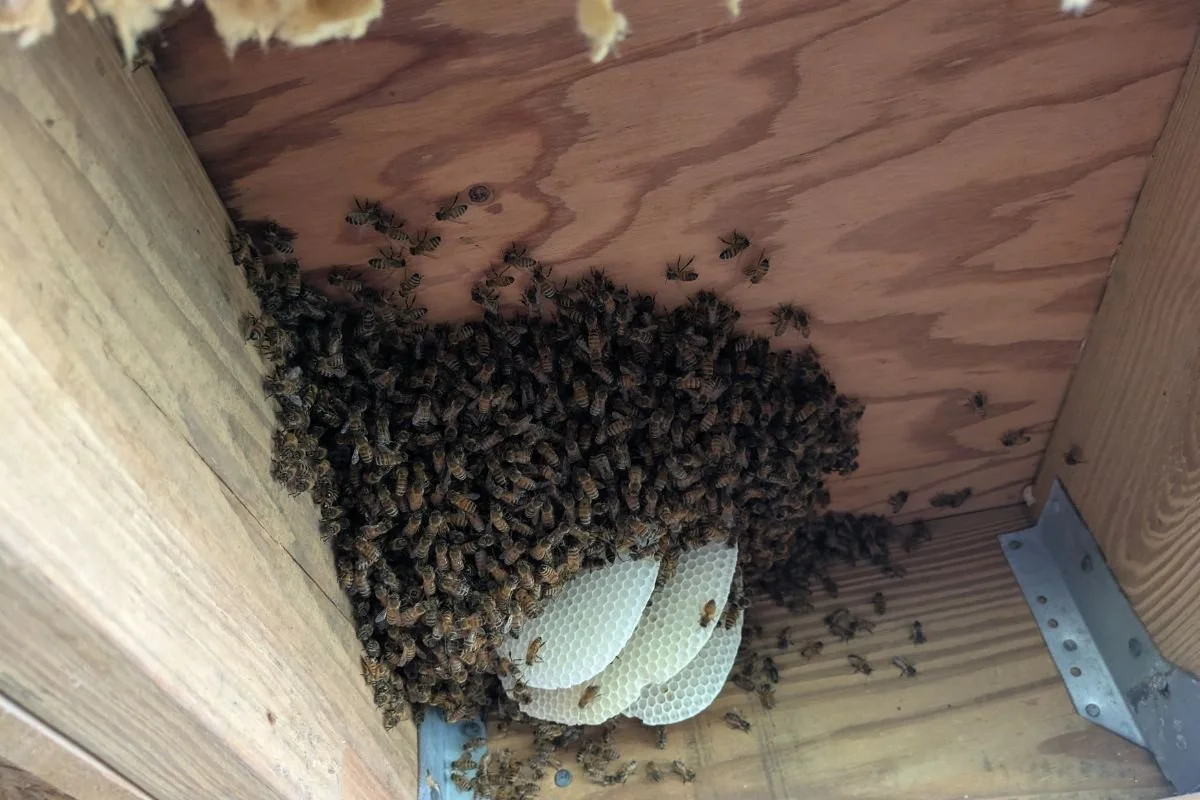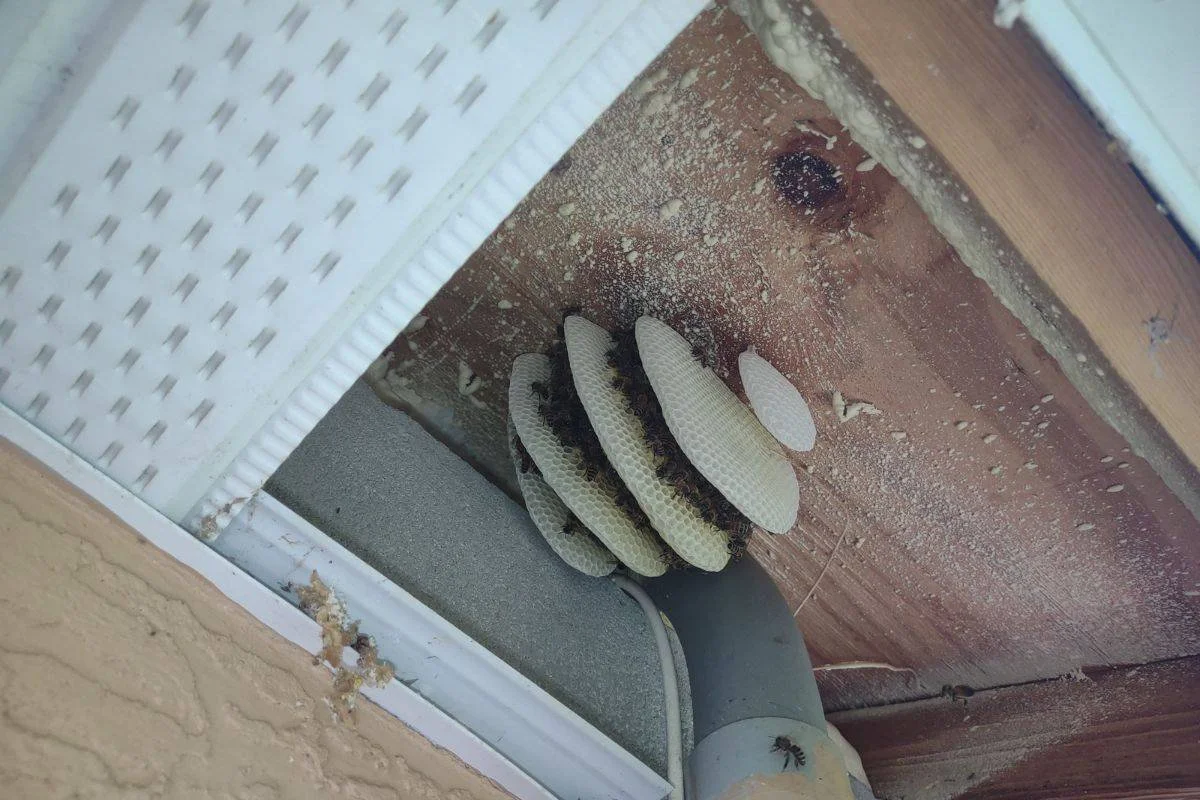🐝 Can Bees Come Back After Removal? Here’s What to Know.
When you’ve gone through the trouble of removing a beehive from your home or property, the last thing you want is for the bees to return. But many homeowners are surprised to see bees buzzing around the same spot just days or weeks after a professional removal. Can bees return after removal? The short answer is yes, they can—but there are important reasons why and ways to prevent it from happening again.
A thriving honeybee colony was found inside a wooden structure.
In this post, we’ll cover:
Why bees return after removal
Common mistakes during removal
How to make sure the colony doesn’t come back
Tips for long-term bee prevention
FAQs about bee removal and re-infestation
The importance of professional live bee removal
🧠 Why Do Bees Return After Removal?
Bees are brilliant and loyal to their hive location. Here are a few reasons why they may return after removal:
1. Leftover Hive Scent
Even after the bees and honeycomb are physically removed, their pheromones can remain in the structure—especially if the hive was inside a wall, soffit, or attic. These scents act as a homing signal for scout bees or nearby swarms.
2. Incomplete Removal
If the entire hive structure (including honeycomb, brood, wax, and debris) is not properly removed, it can attract other bee colonies or pests like ants, cockroaches, and rodents. Even a small leftover piece of wax can trigger a reinfestation.
3. Reinfestation by a New Swarm
Sometimes, a completely new bee colony can move into the same space. This usually happens during the spring or summer swarm season, especially in Florida and other warm climates. If the original access point wasn’t sealed correctly, the area becomes a “prime real estate” for future bees.
🔧 Common Mistakes That Invite Bees Back
Homeowners and even inexperienced pest control companies often make critical mistakes during bee removal that lead to future problems. These include:
Not sealing the entry point after removing the hive
Using poison or killing bees, which leaves the comb to rot inside the wall
Failing to clean and sanitize the area to remove bee pheromones
Covering the hole without removing the hive first, trapping honey and inviting mold or pests
✅ How to Ensure Bees Don’t Come Back
Now that you know why bees return, let’s talk about how to prevent it. Here are proven strategies:
1. Hire a Professional Live Bee Removal Company
Companies like Eco Bee Removal specialize in safe, humane relocation and complete hive removal. Professionals don’t just remove the bees—they also:
An extensive hive hidden behind a soffit shows just how large a colony.
Locate the full extent of the hive
Remove all wax, brood, and honeycomb
Clean and sanitize the area
Seal all entry points with proper materials
Offer bee-proofing services for long-term prevention
2. Seal Entry Points Correctly
After removal, it’s crucial to seal any gaps, cracks, or holes where bees entered. Use durable materials like:
Steel mesh
Expanding foam (in combination with proper sealing)
Caulk and flashing for soffits and roof lines
Bees can squeeze through gaps as small as 1/8 inch, so don’t underestimate small openings.
3. Deodorize the Area
To remove lingering scents, professionals often use natural deterrents or commercial-grade cleaners to neutralize bee pheromones. This step is essential—especially in wall or attic infestations.
4. Monitor the Area After Removal
For the first few weeks after removal, keep an eye on the area. If you see a cluster of bees forming again, call your removal company immediately. Some companies offer warranties or follow-up visits to ensure the job was successful.
🛑 Why DIY Bee Removal Can Make Things Worse
Many property owners try to save money by using smoke, sprays, or sealing hives themselves. But DIY attempts often lead to:
Trapped bees are causing an indoor infestation
Structural damage (from honey melting inside walls)
Legal issues (killing honey bees is illegal in some states)
Repeat infestations due to incomplete removal
💡 Remember: Live bee removal is always safer, more effective, and environmentally responsible.
🐝 How to Keep Bees Away After Removal
Here are some long-term prevention tips to avoid a repeat infestation:
Partially exposed beehive found under house eaves.
✔️ Regular Inspections
Have a professional inspect your home at least once a year, especially before or during swarm season.
✔️ Bee-Proof Construction
When building or renovating:
Use metal screening behind vents
Install tight-fitting soffit and fascia boards
Keep siding sealed and painted
✔️ Remove Attractive Features
Don’t leave sugary drinks or trash outside
Cover compost piles
Keep birdhouses and water meters bee-free
✔️ Plant Wisely
While pollinator-friendly gardens are great, keep bee-attracting flowers like lavender or wildflowers away from your home's structure.
🌎 The Importance of Ethical Bee Removal
At Eco Bee Removal, we believe in saving the bees—not killing them. Honey bees are essential pollinators, responsible for a third of the food we eat. Relocating bees to a safe environment protects:
Local agriculture
Pollinator populations
Ecosystem health
By choosing ethical removal, you protect both your home and the planet.
❓ Frequently Asked Questions (FAQ)
🐝 Can bees remember their old hive location?
Yes. Honey bees can remember the location of their previous hive and may return for several days if pheromones or honey scents remain.
🐝 How long does it take for bees to leave after removal?
If the removal was done properly, most bees leave or die off within 24 to 48 hours. However, straggler bees may linger for up to a week.
🐝 What should I do if bees return after removal?
Contact your bee removal company. If they offer a guarantee or follow-up service, they’ll likely reinspect and seal any new entry points for free or at a reduced cost.
🐝 Will sealing the hive hole be enough?
No. Sealing the hole before removing the hive is a major mistake. The entire hive must be removed first, and the area cleaned and sealed afterward.
🐝 Can a new swarm find the same spot?
Yes. During swarm season, a new queen and her workers can take over an old hive space if the scent is still present and the entry is unsealed.
🐝 Is bee removal covered by homeowner's insurance?
It depends on your policy. Some homeowner’s insurance plans may cover structural damage caused by bees, but not the cost of bee removal. It’s best to check with your insurance provider.
📞 Need Professional Bee Removal in Florida?
Whether bees are in your wall, attic, or roof, Eco Bee Removal can help. We offer:
Live bee removal
Hive cleanup and sanitation
Entry sealing and repair
Bee-proofing services
Free inspections and estimates
✅ Safe for your home
✅ Safe for the environment
✅ Safe for the bees
📍 Serving Florida homeowners with eco-friendly solutions.
👉 Contact Us Today to keep bees from coming back—for good!



